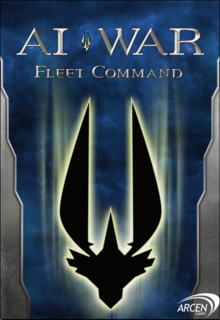INTRO:
As part of a project to make contributions to the Child’s Play charity, Arcen Games has made a game to sell in order to raise funds. The same game has also been made to address some fans’ misgivings about how “easy” the AI is to defeat as long as the player can come up with a long-term plan. It also (partially) addresses the seemingly contradictory and contrasting complaints of other fans who contend that the AI cannot truly be crippled in the long-term.
The expansion pack introduces additional units into AI War, as well as additional gameplay elements which actually introduce one more computer-controlled opponent into a playthrough. This typically makes a playthrough more complicated and difficult – just the way the hardcore fans of AI War would like.
USE OF CONVENIENT CONDITIONS:
For the purpose of this review, a playthrough with specific conditions has been used. These conditions, e.g. difficulty rating of “Sandbox”, render the AI player(s) incredibly lethargic and stupid, as well as grant the player near-perfect intel on the opposition. This is in order to make the behavior of the Hybrid Hive ships more easily observable. (Hybrid Hives will be described further later.)
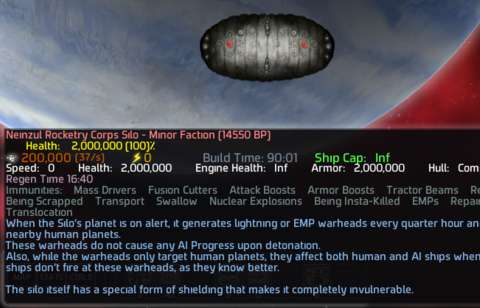
PREMISE:
Perhaps in a slight allegory to what Child’s Play does for children, Arcen Games has designed yet another alien race (in addition to the Zenith in The Zenith Remnant), only this time it is a race with absurdly short lifespans but memories which can survive death and rebirth.
Some of the Neinzul has joined the AI in an unsightly union, embracing the AI’s offer of immortality in return for their servitude. These are the enemies which the player would face if the player turns on the “Hybrid Hives” option, and they will be a thorn on the player’s side from the start of a playthrough to its end, and perhaps even after the AIs have been defeated.
(The Neinzul has been featured in the base version of the game, but only as guard post structures and units which are associated with these structures.)
ADDITIONAL MAP TYPES:
Like The Zenith Remnant, Children of the Neinzul adds to the list of map types. Specifically, these are the “Concentric” and “X” maps.
As its name suggests, Concentric arranges the nodes in the map in concentric circles, with each circle having at least one connection to another circle. These connections typically become convenient chokepoints.
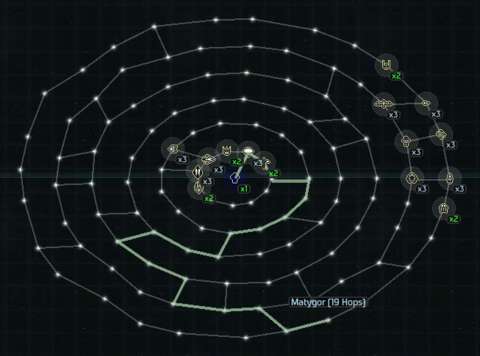
The “X” map type is not as praise-worthy though. It is merely four diametrically opposing lines connected to a single node. This is at best only usable for playthroughs with small numbers of nodes/planets.
ADDITIONAL A.I. TYPES:
There are six additional AI types for the player to pick as adversaries to deal with in a playthrough. Four of these are, typically enough, associated with the Neinzul; they mainly make use of Neinzul assets. They are useful, if the player wants an experience of them being on the AI’s side instead of the player’s.
The other two AI types are a bit more original. The first of these is the “Warp Jumper”, which does not use Warp Gates at all – mainly because it can direct wave attacks on any of the player’s nodes by making use of any of that node’s warp gates.
The “Support Corps” is like the Turtle in the base version of the game; it does not send waves. However, it compensates by giving the other AI player more versatility in its own attack waves. The “Support Corps” also populates its own planets and adjacent AI-controlled planets with defensive units, making them a bit tougher to take down.
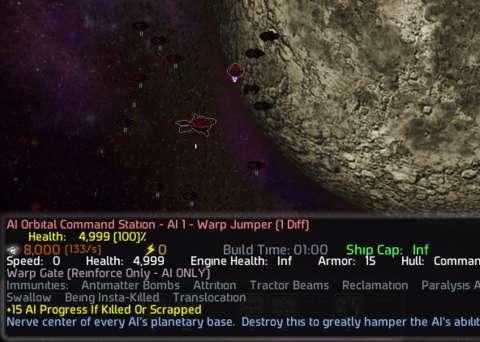
SHORT-LIVED NEINZUL & REGENERATION CHAMBERS:
Somehow, the Neinzul have learned how to preserve their space-faring bodies despite their very short life-spans. This may or may not be a benefit of their collaboration with the AI. This uncertainty is of course irrelevant to the gameplay designs of the Neinzul.
Anyway, all non-starship Neinzul units suffer attrition damage over time. This is not unlike the original concept of the Golems in The Zenith Remnant, but they do not have vast reserves of hitpoints like the Golems do and they cannot be repaired. In other words, they are generally doomed to die after they come out of Docks or any other production sources; they cannot be repaired either.
In return, they gain benefits such as immunity to Reclamation damage. They also generally inflict more raw damage per hit than other units of the same tier.
There are two overall categories of such Neinzul units: drones and “younglings”. Drones have no way to stave off death but are built for free by certain structures and ships. Younglings are not free, but are very cheap and more importantly, have a few ways to stave off death from attrition.
The main way to keep Younglings alive is to have them retreat into structures known as “Regeneration Chambers”. These act a lot like the Barracks structure which the AI uses, except that the player has access to these too. Regeneration Chambers can only be occupied by Neinzul Younglings, who regenerate lost hit points afterwards at an incredible rate without metal costs.
Assault Transports are another alternative. The documentation for this is not entirely clear, but they are supposedly more effective at repairing Neinzul units over time than other units which they are carrying.
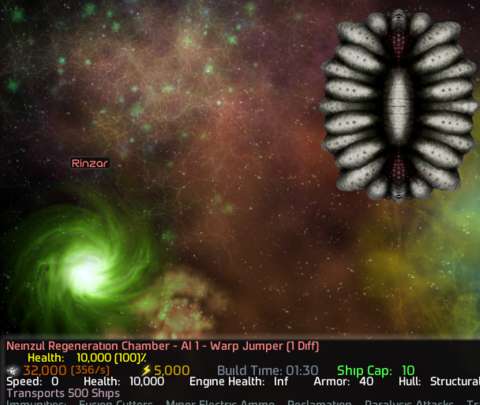
(Speaking of which, assault transports have been revamped to be more useful, but more fragile.)
This combination of Younglings and Regeneration Chambers means that Younglings are best used for purposes of long-term defence. Of course, the player can always resort to assault transports to ferry them around for offensives.
NEINZUL ENCLAVE STARSHIP:
An additional starship type is introduced by this expansion.
It is worth noting here that one of its original abilities is to act as a mobile space dock. This made the Starship too powerful, and also gave rise to misgivings among fans who insisted that a mobile space dock should have been a unit in the vanilla version of the game. This ability has since been folded into the Mobile Space Dock unit, which is available in the base version of AI War.
Currently, the Enclave Starship is an unarmed but relatively tough (and cheap) starship which is capable of spawning sizable numbers of Neinzul drones, which are by default set on “free-roaming” (meaning that they will seek out targets within the same node on their own initiative). In fact, a couple of these Starships can overwhelm nodes early on in a playthrough without any support other than their own drones.
The drones spawned also have balanced weaponry, meaning that there are no enemies which they cannot counter.
However, drones will eventually die, and their motherships cannot produce them rapidly enough to replace them in heated battles. Still, they are useful anyway, if only to provide cannon fodder to absorb shots for the main fleet’s sake.
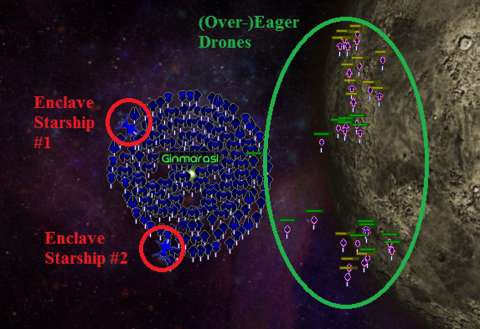
NEINZUL MINOR FACTIONS:
Arcen Games has always been insistent on including what it calls “minor factions” in playthroughs. These are neither within the direct control of the AI or the player character. In the case of Children of the Neinzul, there are three additional minor factions, all of whom are the Neinzul in one form or another.
The most fickle of these are the Roaming Enclaves. As their name suggests, they appear out of nowhere, either to attack the AI or the player, or both. Some of them even become permanent allies of the player; they might even fight each other, amusingly enough.
Anyway, they operate lot like Enclave Starships do, e.g. they spawn units, but these are younglings instead of drones.
Then there are the “Preservation Wardens”. These are purely against the player, because they uphold the idea that natural resources should not be exploited. Since the AI does not need to use natural resources at all, the player is their only target. Like the other Neinzul Enclave ships, they produce short-lived units, in addition to shooting at their targets.
Lastly, there is the Neinzul Rocketry Corps. These are not actual Neinzul per se, but remnants of the Neinzul’s past when they were learning how to travel in space. It so happens that they have somehow made these silos of missiles invulnerable, and the AI has taken them for its own use.
When the silos are alerted, they will continuously build missiles to throw at the player. Even when the planet which they are on has been captured, they remain under the control of the AI and will keep sending missiles.
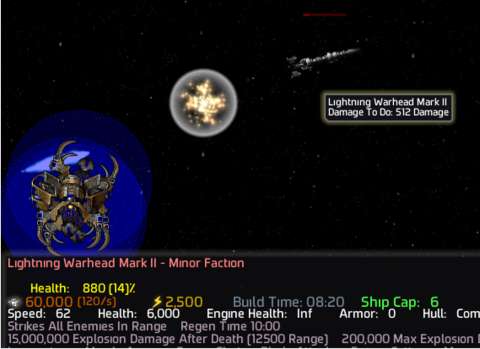
NEINZUL CLUSTERS:
As mentioned earlier, some Neinzul have chosen to side with the AI. Some of them even chose to take up residence close to the AI’s holdings, effectively acting as additional military structures for the AI.
As a general rule of thumb, these structures, known as “clusters”, will create and hold Neinzul units to be deployed en-masse when their ‘homes’ are attacked. This is not unlike the Neinzul Spawner Guard Post seen in the base version of the game, but they do not summon reinforcements like Guard Posts do.
There are several variants of clusters, usually named according to the types of Neinzul units which they stock. A few are unarmed, such as the Neinzul Nests, but these compensate by having risk potential, such as AIP increases when they are destroyed. The armed ones pack less units, but can fire off painful shots.
NEINZUL YOUNGLINGS:
In the base version, the only known Neinzul Younglings are the Cockroaches, which come out of Neinzul Spawner Guard Posts. As long as the player has some way of dealing with their immense numbers, they are hardly a problem.
In Children of the Neinzul, there are more powerful Younglings. They are comparable to the fleet ships in the base game package.
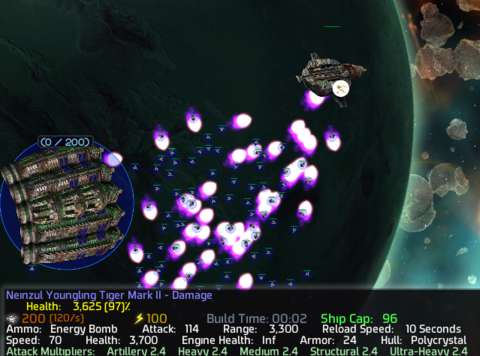
Unfortunately, they seem to be little more than variations or mixtures of existing units and those from The Zenith Remnant. For example, the Viral Swarmers are a lot like the Zenith Auto-Bombers from The Zenith Remnant, except that they inflict Reclamation damage as well, thus giving themselves roles similar to the Parasites’. As another example, there are the Youngling Tigers; they are practically particularly short-ranged Bombers.
Younglings have the advantage of being cheaper than other equivalent fleet units, but this advantage is balanced by the hassle of keeping them alive, if the player wants to use them as more than just one-shot defenses.
HYBRID HIVES & ADVANCED HYBRIDS:
So far, what has been described about the content in Children of the Neinzul is really nothing remarkable; these are mere additional content which does not change the gameplay by much. Even the limited life-spans of Neinzul Younglings would not impress veterans of the base version of AI War – especially those who had already wrangled with the demanding Golems in The Zenith Remnant.
Fortunately, this expansion pack does offer something new, in the form of the AI-Neinzul Hybrid Hives AI Plot. When this AI Plot is enabled, the player is practically adding another computer-controlled opponent in addition to the two AIs (which generally act as a single player anyway).
The potential strength and tenacity of this additional opponent are determined by two factors: the magnitude of the AI Plot itself, and the magnitude of the supplementary AI Plot that is “Advanced Hybrids”.
The first factor determines how many AI-Neinzul Hybrid Hive ships which the player has to contend with. A higher magnitude means that there are more structures which spawn these ships, and thus there will be more of them to contend with.
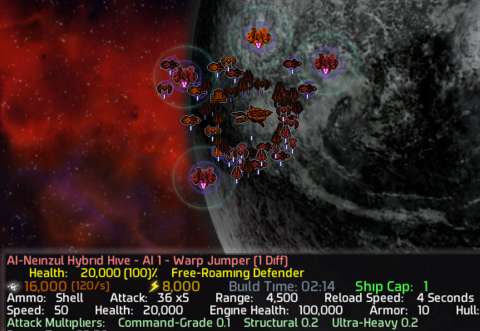
The second factor can only work if the first has been enabled. It determines how sophisticated the behavior of the Hybrid Hive ships will be. Without it enabled, the Hive Ships are little more than additional muscle for the AI. With a higher rating though, they begin to seem more proactive, and more quickly so too.
For example, they distribute themselves along multiple fronts, concentrating at nodes which are important to the AI’s efforts. They also attack when the player is paying attention to somewhere else (not unlike what the AI does).
Such behavior is done almost independently of the AI player. The Hybrid Hive ships do sometimes coordinate with the AI on attacks, but that is just about it.
At high ratings of “Advanced Hybrids”, they obtain the ability to build more facilities to support themselves with, including even new Hive Spawners. This can quickly ruin a playthrough if the player does not actively work against them.
Fortunately, to prevent Hive ships with high “Advanced Hybrid” ratings from simply overrunning the player, they have a limitation: their age. New Hive ships cannot do much other than protect the AI’s holdings. The ones which had been around for longer begin to have access to more behavior scripts, as dictated by the “Advanced Hybrid” rating.
These “older” Hive ships may take on roles which are more active than just defending the AI’s holdings and joining attacks when the opportunity arises. For example, they may go about making hit-and-run attacks, requisitioning more drones than usual to support them in doing so. The most sophisticated role which they may get is the one which lets them build more Hybrid facilities.
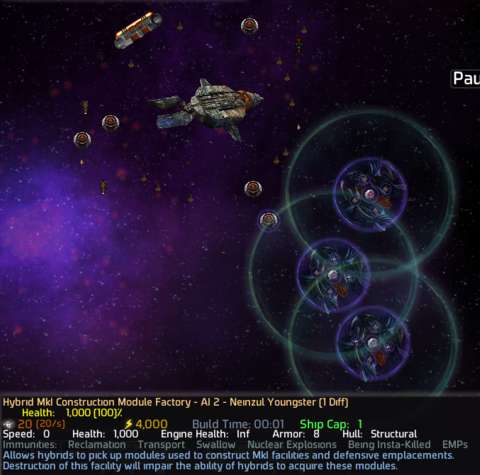
HYBRID FACILITIES:
When the player starts a playthrough with the Hybrid Hive AI Plot enabled, structures which support the proliferation and operation of Hybrid Hives are seeded into the map. Chief of these are Hive Spawners, which build new Hybrid Hive ships over time.
The Hybrid Hives are then joined by special Youngling units, which are created from other Hive-supporting structures. These last a lot longer than most other Younglings, and more importantly, appear to heal when they are in AI-controlled territory. Therefore, Hives are rarely caught alone.
Next, there are structures which allow the Hives to make use of their module slots; these are very similar to those which Riot Control Starships use. With these structures, they can fill in these slots with additional offensive and defensive hardware, thus making them more powerful than their sprites suggest.
However, the long-term capabilities of the Hybrid Hives are mainly tied to these facilities; they do not receive any direct support from the AI.
Presumably, the player could cripple the Hybrid Hives in the long-run by going after their facilities. This is in contrast with what the player can do against the AI; anything which the player does against the AI just makes it angrier and more cunning. The most which the player can do against the AI in the long-run is to hack Design Backups and deny unit types to the AI, but this in itself comes with opportunity costs.
On the other hand, dealing with the Hybrid Hives means time taken away from actually advancing against the AI.
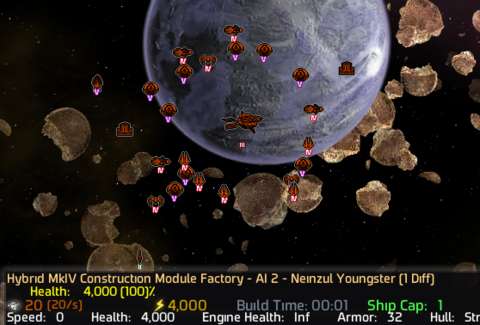
Yet, if the player ignores the Hybrid Hives for too long, the survivors become more proactive over time; this happens faster with a higher “Advanced Hybrids” rating. As this happens, they begin to build more and higher quality Hybrid facilities, including additional spawners; a metaphorical thorn in the player’s side eventually become a metaphorical nail, and then a stake.
This means that enabling the Hybrid Hives options in a playthrough is not for players who are new to AI War. Arcen Games itself has said that they can make a playthrough far more difficult than it could be, and it is right.
POST-V7.000 NEINZUL BALANCING:
After the major game overhaul that was version 7.000, Neinzul units have been balanced around left and right. The one affected the most is the Neinzul Enclave Starship, which has been nerfed and buffed so many times that it is still considered unbalanced by some.
The Younglings are less problematic, though their cost-effectiveness is still in flux. Their short lives but cheap costs mean that they are still little more than one-shot units; the benefits of keeping them around with Regeneration Chambers and Assault Transports are still debatable.
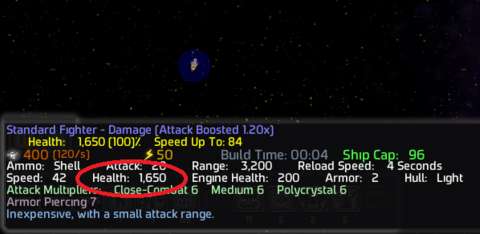
POST-V8.000 CHANGES - DROPPING ZEROES:
As of version 8.000, a lot of numbers have had zeroes trimmed off them, purportedly in order for AI War to run more smoothly. For example, two zeroes have been taken off the hitpoint counts of almost all units. The end result is that the statistical performance and capabilities of units and structures had not changed at all.
ASSAULT TRANSPORT RE-BALANCING:
At this time of writing, there has been a change in how Transports work, or more precisely, how other units work relative to the Transports.
The main change here is that many units have lost their ‘immunity’ to being transported, especially starships. Previously, Starships have to be moved separately, while the player can move fleet ships around quickly in the fast transports; this can be a problem if the player uses slow starships, such as the Plasma Siege starships.
This is no longer the case. Starships, and many other slow and vulnerable units, can be stuffed inside transports and assault transports, thus allowing the player to quickly ship them around.
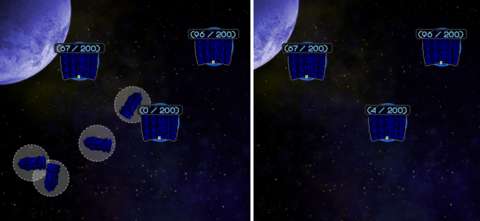
RAID STARSHIP RE-BALANCING:
Before the current build of the game (at this time of writing, version 8.016), Raid Starships are practically the fastest ships in the game. Their speed has since been nerfed by half. They are still the fastest starships around, but there are other units which are now faster than they are, namely transports. Most Neinzul Younglings are also faster than they are, so the cheesy tactic of having rapidly dying Younglings go on a wild goose chase after the then-faster Raid Starships no longer works.
MUSIC:
Expectedly, Pablo Vega provides the soundtracks for this expansion pack. There are only three additional tracks, however. Like the tracks which he had made before for AI War, they are not exactly thematically matching, but are melodious enough to be worthwhile listening to while playing the game.
VISUAL DESIGNS:
As to be expected of a race of giant sentient space-faring bugs, the Neinzul are hideous to look at. Yet, their artwork seems a lot more convincing than the artwork for existing content in the base version of the game. To elaborate, at least their organic look is appropriate; the organic look for non-Neinzul units make them look awful.
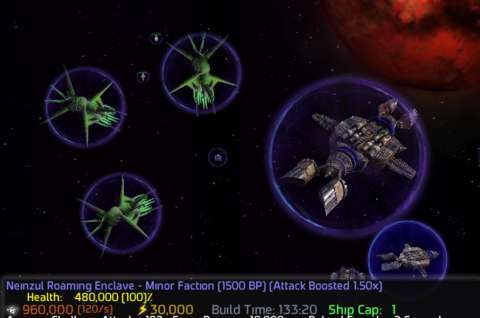
SUMMARY:
Much of the content in Children of the Neinzul could have been included in the base game package, seeing that this does not add anything excitingly new to the gameplay of AI War; even the notion of units with short shelf-lives is nothing new.
However, the addition of the Hybrid Hives as practically another long-term computer-controlled opponent is notable. This option offers an opponent which does not play according to the same rules as the AI does, thus making a playthrough more complex, though at the cost of being more complicated.
In other words, this expansion stays true to the themes of AI War, e.g. pervasive opportunity costs, while having features which make it stand out from the other expansions.
